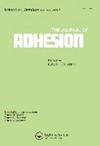Experimental investigation and molecular simulation on the chemical bonding between laser-treated titanium alloy amorphous surface and epoxy adhesive
IF 2.3
4区 材料科学
Q2 ENGINEERING, CHEMICAL
引用次数: 0
Abstract
ABSTRACTLaser surface modification is employed to enhance the interfacial bonding performance of metal-adhesive structures, and chemical bonding plays a crucial role in achieving strong interfacial adhesion. Understanding the mechanism of interfacial chemical bonding between laser-treated metal surface and adhesive at the molecular/atomic scale is key to further optimizing the interfacial bonding performance. In this study, the morphology and chemical composition of laser-induced amorphous titanium oxide on titanium alloy surfaces, as well as its enhanced effect on interfacial bonding performance, were characterized using scanning electron microscopy, energy dispersive spectroscopy, and single lap-shear testing.Through X – ray photoelectron spectroscopy analysis, experimental evidence is provided for the formation of Ti-O-C chemical bonds between the amorphous titanium oxide and adhesive. Transmission electron microscopy observations and molecular dynamics simulations reveal that the strong non-bonding intereactions between amorphous titanium oxide and adhesive enables the adhesive molecules to fully infiltrate the amorphous titanium oxide, providing more sites for chemical bond formation. Density functional theory calculations demonstrate that Ti-O-C chemical bonds tend to form between the dissociated hydroxyl group of the adhesive and titanium oxide, facilitated by a relatively low reaction barrier. This chemical bonding promote the formation of a strong bonding structure at the adhesive interface.KEYWORDS: Chemical bondinglaser ablationamorphous titanium oxideadhesive bondedmolecular simulation AcknowledgmentsThis work was supported by the International Exchange Program for Graduate Students, Tongji University (2023020021).The authors acknowledge the Adaptive Bonding Interface Behavior of Typical Automotive Sheet Metals with Coating project for providing financial support. Additionally, the authors extend their thanks to the School of Materials Science and Engineering, Tongji University for providing Materials Studio software which was used to perform computational work presented in this paper.Disclosure statementThe authors declare that they have no known competing financial interests or personal relationships that could have appeared to influence the work reported in this paper.Author contributionsShuangshuang Li: Validation, Visualization, Writing-original draft; Jianping Lin: Supervision, Conceptualization, Formal analysis, Writing – review & editing; Junying Min: Resources; Funding acquisition.Additional informationFundingThis work was supported by the International Exchange Program for Graduate Students [2023020021].激光处理钛合金非晶态表面与环氧胶粘剂化学键合的实验研究与分子模拟
摘要激光表面改性是提高金属-粘接结构界面粘接性能的重要手段,而化学键合是提高金属-粘接结构界面粘接性能的关键。在分子/原子尺度上了解激光处理金属表面与胶粘剂之间的界面化学键合机理是进一步优化界面键合性能的关键。本研究采用扫描电镜、能量色散光谱、单搭剪测试等方法,表征了激光诱导钛合金表面非晶态氧化钛的形貌、化学成分及其对界面结合性能的增强作用。通过X射线光电子能谱分析,为无定形氧化钛与胶粘剂之间形成Ti-O-C化学键提供了实验证据。透射电镜观察和分子动力学模拟表明,非晶态氧化钛与胶粘剂之间的强非键相互作用使得胶粘剂分子能够充分渗透到非晶态氧化钛中,为化学键的形成提供了更多的位点。密度泛函理论计算表明,相对较低的反应势垒有助于在黏合剂的解离羟基与氧化钛之间形成Ti-O-C化学键。这种化学键合促进了在粘接界面处形成牢固的键合结构。关键词:化学键合;激光烧蚀;非晶态氧化钛;作者承认典型汽车钣金与涂装项目的自适应粘接界面行为提供了资金支持。此外,作者还对同济大学材料科学与工程学院提供的Materials Studio软件表示感谢,该软件用于完成本文的计算工作。披露声明作者声明,他们没有已知的竞争经济利益或个人关系,可能会影响本文所报道的工作。李双爽:验证、可视化、撰写原稿;林建平:监督、构思、形式分析、写作—审稿编辑;闵俊英:资源;融资收购。本研究由研究生国际交流项目[2023020021]资助。
本文章由计算机程序翻译,如有差异,请以英文原文为准。
求助全文
约1分钟内获得全文
求助全文
来源期刊

Journal of Adhesion
工程技术-材料科学:综合
CiteScore
5.30
自引率
9.10%
发文量
55
审稿时长
1 months
期刊介绍:
The Journal of Adhesion is dedicated to perpetuating understanding of the phenomenon of adhesion and its practical applications. The art of adhesion is maturing into a science that requires a broad, coordinated interdisciplinary effort to help illuminate its complex nature and numerous manifestations.
 求助内容:
求助内容: 应助结果提醒方式:
应助结果提醒方式:


